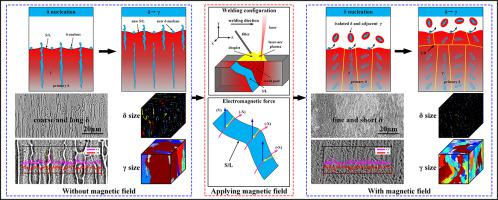当前位置:
X-MOL 学术
›
Mater. Des.
›
论文详情
Our official English website, www.x-mol.net, welcomes your
feedback! (Note: you will need to create a separate account there.)
Altering morphological, crystalline and compositional features in 316 L laser-MIG weldments with an external magnetic field
Materials & Design ( IF 7.6 ) Pub Date : 2020-11-01 , DOI: 10.1016/j.matdes.2020.109156 Zhengwu Zhu , Xiuquan Ma , Chunming Wang , Gaoyang Mi
Materials & Design ( IF 7.6 ) Pub Date : 2020-11-01 , DOI: 10.1016/j.matdes.2020.109156 Zhengwu Zhu , Xiuquan Ma , Chunming Wang , Gaoyang Mi

|
Abstract Narrow gap multi-layer hybrid welding technology is an efficient way to join thick plates of metal or alloys. However, the coarse microstructure and solute segregation were caused by rapid cooling. In this paper, a magnetic field was utilized to achieve better microstructural control during welding. Using analytical electron microscopy combining with EDS and EBSD, microstructure evolution including grain growth and solute segregation during electromagnetic stirring (EMS) was systematically studied. EMS promoted the refinement and suppressed the overgrowth of austenite (γ) grains. Besides, γ exhibited equiaxed grains as seen from both grain size and texture evolution. For ferrite (δ) dendrites, EMS promoted the morphological transition from the coarse and long vermicular morphology to the fine lathy forms. EMS also induced deviation and discontinuity in δ dendrite growth. From chemical compositions point-of-view, a homogeneous distribution was obtained at both macro- and micro-scales by EMS. These results were attributed to δ “dendrite fragmentation” behavior brought by electromagnetic force at solid/liquid interface. Such δ fragments grew and acted as a substrate for epitaxial γ grains nucleation, with specific γ/δ orientation relationships, suppressing continuous epitaxial growth of γ grains via increased nucleation. Moreover, δ fragments result in reduced fraction of δ phase and dispersed distribution.
中文翻译:

使用外部磁场改变 316 L 激光 MIG 焊件的形态、结晶和成分特征
摘要 窄间隙多层复合焊接技术是连接金属或合金厚板的有效方法。然而,粗大的组织和溶质偏析是由快速冷却引起的。在本文中,利用磁场在焊接过程中实现更好的微观结构控制。使用分析电子显微镜结合EDS和EBSD,系统地研究了电磁搅拌(EMS)过程中包括晶粒生长和溶质偏析在内的微观结构演变。EMS促进了细化并抑制了奥氏体(γ)晶粒的过度生长。此外,从晶粒尺寸和织构演变来看,γ 表现出等轴晶粒。对于铁素体 (δ) 枝晶,EMS 促进了从粗长蠕虫状形态到细条状形态的形态转变。EMS 还引起δ 枝晶生长的偏差和不连续性。从化学成分的角度来看,EMS 在宏观和微观尺度上都获得了均匀分布。这些结果归因于固/液界面电磁力带来的δ“枝晶破碎”行为。这种δ碎片生长并作为外延γ晶粒成核的基底,具有特定的γ/δ取向关系,通过增加成核抑制γ晶粒的连续外延生长。此外,δ 碎片导致 δ 相的分数和分散分布的减少。这些结果归因于固/液界面电磁力带来的δ“枝晶破碎”行为。这种δ碎片生长并作为外延γ晶粒成核的基底,具有特定的γ/δ取向关系,通过增加成核抑制γ晶粒的连续外延生长。此外,δ 碎片导致 δ 相的分数和分散分布的减少。这些结果归因于固/液界面电磁力带来的δ“枝晶破碎”行为。这种δ碎片生长并作为外延γ晶粒成核的基底,具有特定的γ/δ取向关系,通过增加成核抑制γ晶粒的连续外延生长。此外,δ 碎片导致 δ 相的分数和分散分布的减少。
更新日期:2020-11-01
中文翻译:

使用外部磁场改变 316 L 激光 MIG 焊件的形态、结晶和成分特征
摘要 窄间隙多层复合焊接技术是连接金属或合金厚板的有效方法。然而,粗大的组织和溶质偏析是由快速冷却引起的。在本文中,利用磁场在焊接过程中实现更好的微观结构控制。使用分析电子显微镜结合EDS和EBSD,系统地研究了电磁搅拌(EMS)过程中包括晶粒生长和溶质偏析在内的微观结构演变。EMS促进了细化并抑制了奥氏体(γ)晶粒的过度生长。此外,从晶粒尺寸和织构演变来看,γ 表现出等轴晶粒。对于铁素体 (δ) 枝晶,EMS 促进了从粗长蠕虫状形态到细条状形态的形态转变。EMS 还引起δ 枝晶生长的偏差和不连续性。从化学成分的角度来看,EMS 在宏观和微观尺度上都获得了均匀分布。这些结果归因于固/液界面电磁力带来的δ“枝晶破碎”行为。这种δ碎片生长并作为外延γ晶粒成核的基底,具有特定的γ/δ取向关系,通过增加成核抑制γ晶粒的连续外延生长。此外,δ 碎片导致 δ 相的分数和分散分布的减少。这些结果归因于固/液界面电磁力带来的δ“枝晶破碎”行为。这种δ碎片生长并作为外延γ晶粒成核的基底,具有特定的γ/δ取向关系,通过增加成核抑制γ晶粒的连续外延生长。此外,δ 碎片导致 δ 相的分数和分散分布的减少。这些结果归因于固/液界面电磁力带来的δ“枝晶破碎”行为。这种δ碎片生长并作为外延γ晶粒成核的基底,具有特定的γ/δ取向关系,通过增加成核抑制γ晶粒的连续外延生长。此外,δ 碎片导致 δ 相的分数和分散分布的减少。









































 京公网安备 11010802027423号
京公网安备 11010802027423号